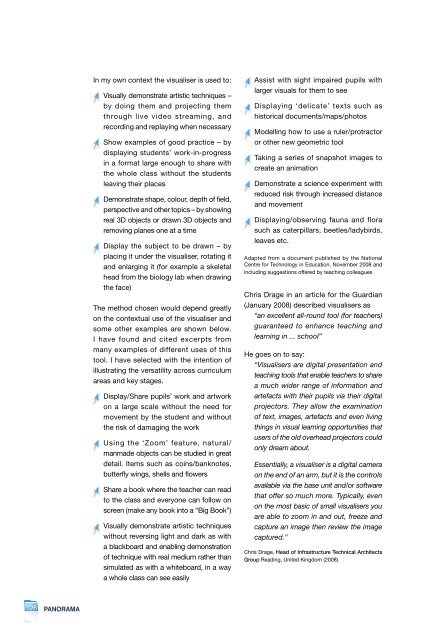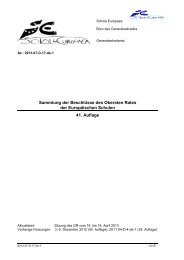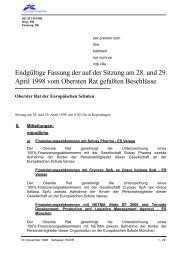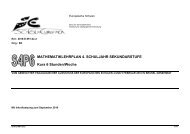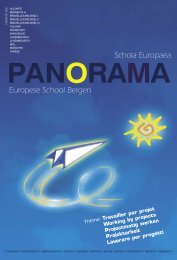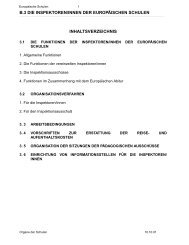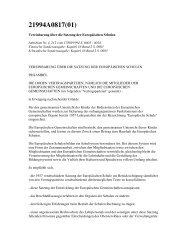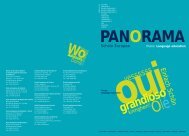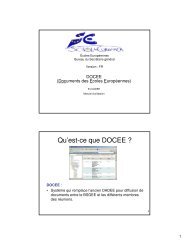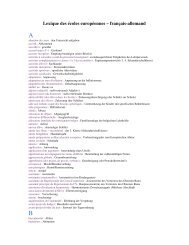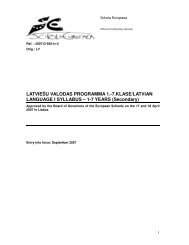Schola Europaea European School Brussels II
Schola Europaea European School Brussels II
Schola Europaea European School Brussels II
Create successful ePaper yourself
Turn your PDF publications into a flip-book with our unique Google optimized e-Paper software.
126<br />
PANORAMA<br />
In my own context the visualiser is used to:<br />
Visually demonstrate artistic techniques –<br />
by doing them and projecting them<br />
through live video streaming, and<br />
recording and replaying when necessary<br />
Show examples of good practice – by<br />
displaying students’ work-in-progress<br />
in a format large enough to share with<br />
the whole class without the students<br />
leaving their places<br />
Demonstrate shape, colour, depth of field,<br />
perspective and other topics – by showing<br />
real 3D objects or drawn 3D objects and<br />
removing planes one at a time<br />
Display the subject to be drawn – by<br />
placing it under the visualiser, rotating it<br />
and enlarging it (for example a skeletal<br />
head from the biology lab when drawing<br />
the face)<br />
The method chosen would depend greatly<br />
on the contextual use of the visualiser and<br />
some other examples are shown below.<br />
I have found and cited excerpts from<br />
many examples of different uses of this<br />
tool. I have selected with the intention of<br />
illustrating the versatility across curriculum<br />
areas and key stages.<br />
Display/Share pupils’ work and artwork<br />
on a large scale without the need for<br />
movement by the student and without<br />
the risk of damaging the work<br />
Using the ‘Zoom’ feature, natural/<br />
manmade objects can be studied in great<br />
detail. Items such as coins/banknotes,<br />
butterfly wings, shells and flowers<br />
Share a book where the teacher can read<br />
to the class and everyone can follow on<br />
screen (make any book into a “Big Book”)<br />
Visually demonstrate artistic techniques<br />
without reversing light and dark as with<br />
a blackboard and enabling demonstration<br />
of technique with real medium rather than<br />
simulated as with a whiteboard, in a way<br />
a whole class can see easily<br />
Assist with sight impaired pupils with<br />
larger visuals for them to see<br />
Displaying ‘delicate’ texts such as<br />
historical documents/maps/photos<br />
Modelling how to use a ruler/protractor<br />
or other new geometric tool<br />
Taking a series of snapshot images to<br />
create an animation<br />
Demonstrate a science experiment with<br />
reduced risk through increased distance<br />
and movement<br />
Displaying/observing fauna and flora<br />
such as caterpillars, beetles/ladybirds,<br />
leaves etc.<br />
Adapted from a document published by the National<br />
Centre for Technology in Education, November 2008 and<br />
including suggestions offered by teaching colleagues<br />
Chris Drage in an article for the Guardian<br />
(January 2008) described visualisers as<br />
“an excellent all-round tool (for teachers)<br />
guaranteed to enhance teaching and<br />
learning in ... school”<br />
He goes on to say:<br />
“Visualisers are digital presentation and<br />
teaching tools that enable teachers to share<br />
a much wider range of information and<br />
artefacts with their pupils via their digital<br />
projectors. They allow the examination<br />
of text, images, artefacts and even living<br />
things in visual learning opportunities that<br />
users of the old overhead projectors could<br />
only dream about.<br />
Essentially, a visualiser is a digital camera<br />
on the end of an arm, but it is the controls<br />
available via the base unit and/or software<br />
that offer so much more. Typically, even<br />
on the most basic of small visualisers you<br />
are able to zoom in and out, freeze and<br />
capture an image then review the image<br />
captured.”<br />
Chris Drage, Head of Infrastructure Technical Architects<br />
Group Reading, United Kingdom (2008)


